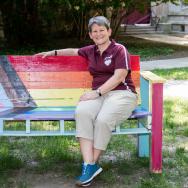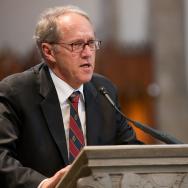Editor’s note: This story is part of ‘Meet a UChicagoan,’ a regular series focusing on the people who make UChicago a distinct intellectual community. Read about the others here.
In Dave Kaleta’s home in Chicago, you’ll find three display cabinets filled with colorful sculptures of his own design: nine miniature scenes from his daily life; an enormous frog, mid-dissection; and a Wizard of Oz hot air balloon.
But you won’t find any clay, wood or stone in his creations. They are all made with LEGO bricks—the subject of Kaleta’s passion since age 4, and an indispensable tool in his kindergarten classroom.
“I think most educators think about using LEGO to teach math and science, like building a simple machine,” said Kaleta, a 1995 graduate of the University of Chicago Laboratory Schools, where he has taught for the past 20 years. “But I want kids to see it more as an expression of art.”
Kaleta’s lifelong love has taken him to competitions around the world, including the current season of the LEGO Masters TV show, and informed his teaching philosophy. Alongside easels and paints, his classroom has a LEGO studio. On display are LEGO art books featuring his work and that of other artists, to both inspire his students and show them that LEGO can be taken seriously—just like drawing and painting.
He also uses LEGO as a way to teach kids how to solve problems. An improviser who free-hands most of his own sculptures, Kaleta asks his students about their initial plans to build, what they had to change along the way and what they learned from the experience. “They learn that it’s OK to edit,” he said. “The first thing you do is not always going to work, and it’s the same for me, too.”
“What I want them to get out of using LEGO is to think outside the box,” he added.
He credits his own Lab education as a formative influence. Enrolled at Lab for all but one year of his N-12 education, Kaleta remembers how his teachers taught him “to ask questions, to not accept the status quo, and to create your own voice. Those are all the things that I try to put into my use of Lego, whether I’m building or teaching with it.”
Kaleta’s use of LEGO, said assistant principal Sarah Abella, fits perfectly within Lab’s mission to encourage children to pursue what they truly love.
“Dave models for children how he follows his passion and encourages them to follow theirs, whether it be superheroes, writing, building or music,” said Abella, LAB’93. “Children are led by Dave’s example of digging deep into something that matters to you.”
Lab’s innovative early childhood program has long been guided by the Reggio Emilia approach, which emphasizes the ability of children to teach themselves through their interactions with their classmates, teachers and environment. As a child, Kaleta found himself channeling this philosophy, even when he left the Lab campus. When he was 8 years old, Kaleta’s mom would bring him to the daycare she ran for Chicago City Colleges. He’d tote along his giant sack of LEGO bricks and sit on the floor, building with the preschool kids.
“And the daycare teachers always said that the children built differently after they had built with me,” he said. “Seeing someone doing something differently can change the way you do it, too.”
His skills have come in handy on the second season of LEGO Masters, in which teams of amateur builders compete in a set of timed, themed challenges. Kaleta said he and his teammate, Richard Dryden of New York, have tried to show that “Lego can be more than just building cool stuff. You can build with intention, and evoke feeling and place in your work.”
Originally scouted for the first season of LEGO Masters along with his wife Devon Wilkop (herself a builder), Kaleta said his experience participating in the competition presented him with the most challenging Lego projects of his life. So far, Kaleta has won one of the competitions—building a massive tower that survived an “earthquake”—and survived elimination the following week despite his team’s LEGO headdress falling apart during judging.
Kaleta has also seen parallels between his experience on LEGO Masters and his day job. Although he is competing against others, the show still fosters a team spirit that reminds him of his work with other teachers. “I hope to use the lessons I learned on collaboration and creative thinking in my classroom and with my colleagues,” he said.
Competing on LEGO Masters isn’t the first time Kaleta has been honored for his acumen and artistry. The dissected frog performed well in an online LEGO Olympics tournament in 2010, and as a result was featured on the Discovery Channel, in The Telegraph in the U.K., and was displayed at London’s Victoria and Albert Museum in an exhibit on expert crafting—next to a pair of Alexander McQueen shoes.
When he attended Brickworld, the largest LEGO convention in North America, for the first time in 2009, he brought a multi-level Batcave with him: about four feet tall, approximately 50,000 pieces and five years in the making, it won Best Mega Creation.
Kaleta estimates that he now has well over 100,000 pieces in his collection. “I know it’s less than 500,000, but I also know it’s too many!”
Sometimes he can reflect upon his life from looking at things he’s made. After his son was born, he built a sign of his name with the letters gently spinning. The base of the piece had elements sampled from his own childhood collection: an old battle axe from a castle set he played with when he was 10, a wrench from his first motorcycle repair shop set he got on his eighth birthday and a fence element from one of his favorite LEGO space themes.
“I remember using those pieces to build stuff when I was a kid, and I’m still using the same pieces as an adult,” he said.
This includes sharing his love of LEGO with his 6-year-old son Elliot, who takes over the family studio when Kaleta is out of town.
“One of the things we’re trying to teach in the classroom is that you can take your Lego apart and build something new with it, reuse the material and keep going,” Kaleta said. “And you know, given the state of what the LEGO room looks like when I get back, I think my son has really embraced that.”

